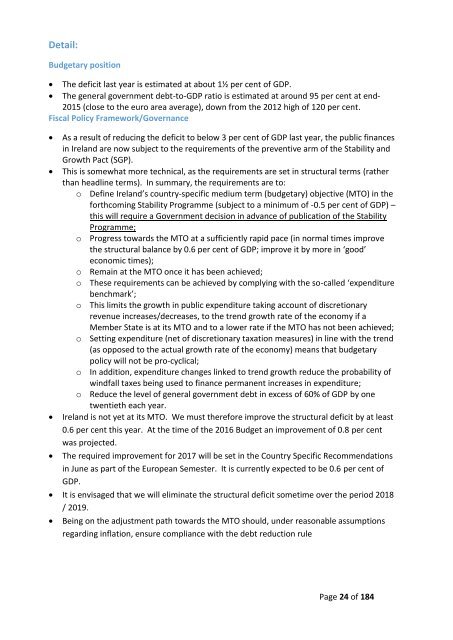Minister’s Brief
20160229%20Minister%20for%20Finance%20Brief%20redacted%20web
20160229%20Minister%20for%20Finance%20Brief%20redacted%20web
Create successful ePaper yourself
Turn your PDF publications into a flip-book with our unique Google optimized e-Paper software.
Detail:<br />
Budgetary position<br />
The deficit last year is estimated at about 1½ per cent of GDP.<br />
The general government debt-to-GDP ratio is estimated at around 95 per cent at end-<br />
2015 (close to the euro area average), down from the 2012 high of 120 per cent.<br />
Fiscal Policy Framework/Governance<br />
<br />
<br />
<br />
<br />
As a result of reducing the deficit to below 3 per cent of GDP last year, the public finances<br />
in Ireland are now subject to the requirements of the preventive arm of the Stability and<br />
Growth Pact (SGP).<br />
This is somewhat more technical, as the requirements are set in structural terms (rather<br />
than headline terms). In summary, the requirements are to:<br />
o Define Ireland’s country-specific medium term (budgetary) objective (MTO) in the<br />
forthcoming Stability Programme (subject to a minimum of -0.5 per cent of GDP) –<br />
this will require a Government decision in advance of publication of the Stability<br />
Programme;<br />
o Progress towards the MTO at a sufficiently rapid pace (in normal times improve<br />
the structural balance by 0.6 per cent of GDP; improve it by more in ‘good’<br />
economic times);<br />
o Remain at the MTO once it has been achieved;<br />
o These requirements can be achieved by complying with the so-called ‘expenditure<br />
benchmark’;<br />
o This limits the growth in public expenditure taking account of discretionary<br />
revenue increases/decreases, to the trend growth rate of the economy if a<br />
Member State is at its MTO and to a lower rate if the MTO has not been achieved;<br />
o Setting expenditure (net of discretionary taxation measures) in line with the trend<br />
(as opposed to the actual growth rate of the economy) means that budgetary<br />
policy will not be pro-cyclical;<br />
o In addition, expenditure changes linked to trend growth reduce the probability of<br />
windfall taxes being used to finance permanent increases in expenditure;<br />
o Reduce the level of general government debt in excess of 60% of GDP by one<br />
twentieth each year.<br />
Ireland is not yet at its MTO. We must therefore improve the structural deficit by at least<br />
0.6 per cent this year. At the time of the 2016 Budget an improvement of 0.8 per cent<br />
was projected.<br />
The required improvement for 2017 will be set in the Country Specific Recommendations<br />
in June as part of the European Semester. It is currently expected to be 0.6 per cent of<br />
GDP.<br />
It is envisaged that we will eliminate the structural deficit sometime over the period 2018<br />
/ 2019.<br />
<br />
Being on the adjustment path towards the MTO should, under reasonable assumptions<br />
regarding inflation, ensure compliance with the debt reduction rule<br />
Page 24 of 184


